Tulips, planting guide and care work
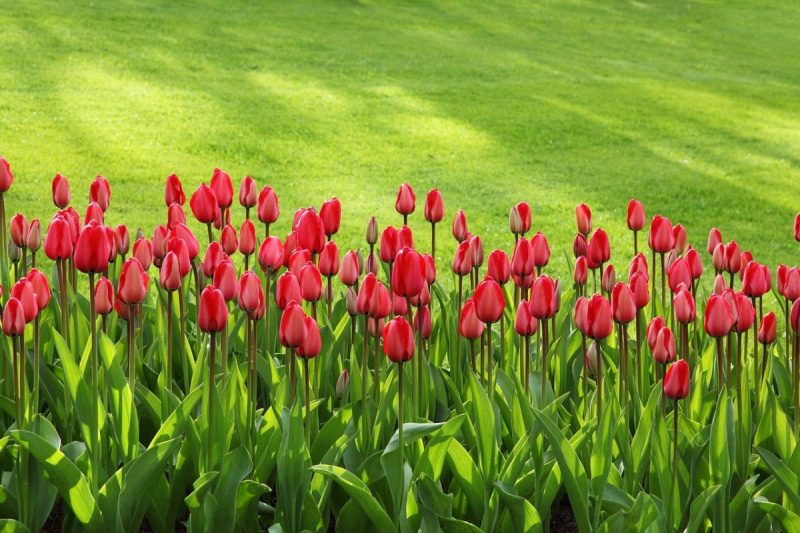
Tulips (genus Tulipa) – perennial herbaceous plants, flowering, well-known for their large flowers, variously colored, specific to springtime. They are part of the Liliaceae family, are bulbous plants (with underground bulbs). They originate from Central Asia and Southern Europe, being cultivated in Persia since the 10th century. They were brought and naturalized in Europe, from the Ottoman Empire, starting with the 16th century. They bloom in early spring, becoming one of the symbols of this season. In summer, after losing the flowers, it enters a dormancy period, and the aerial parts of the plant wither completely.
Tulips are flowers appreciated all over the world, being cultivated in gardens, as ornamental plants, or used as cut plants, in bouquets and floral arrangements.
About 75 species of tulips are known, from which thousands of hybrids and cultivars were obtained, with flowers in different shapes and colors. Depending on the species, their height can vary between 10 and 70 cm. The flower is hermaphroditic and actinomorphic (it has radial symmetry), with the shape of a cup or a star. It consists of two rows with 3 tepals each (sepals and petals combined in the same tissue), of different colors and shapes, depending on the variety. The fruit has the shape of an ellipsoidal capsule, divided into 3 chambers, in which the seeds can be found. The stem is represented by the floral stem, at the base of which there is a rosette of leaves covered by a waxy, protective layer (2-6 leaves). The bulb is ovoid or pear-shaped and has a brown protective coating.
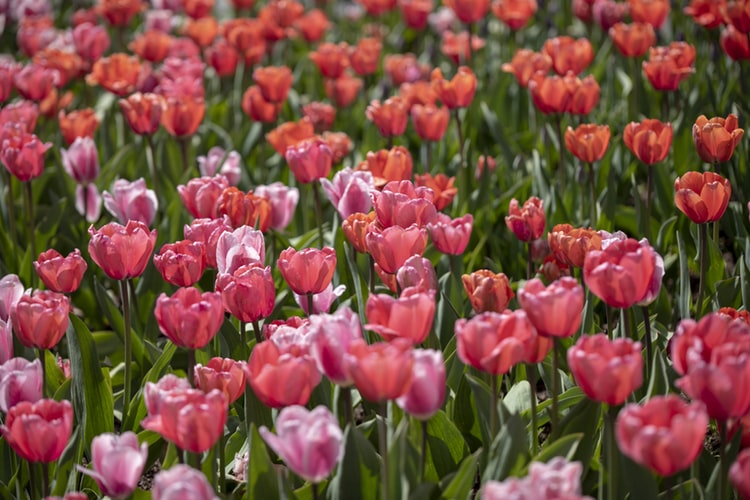
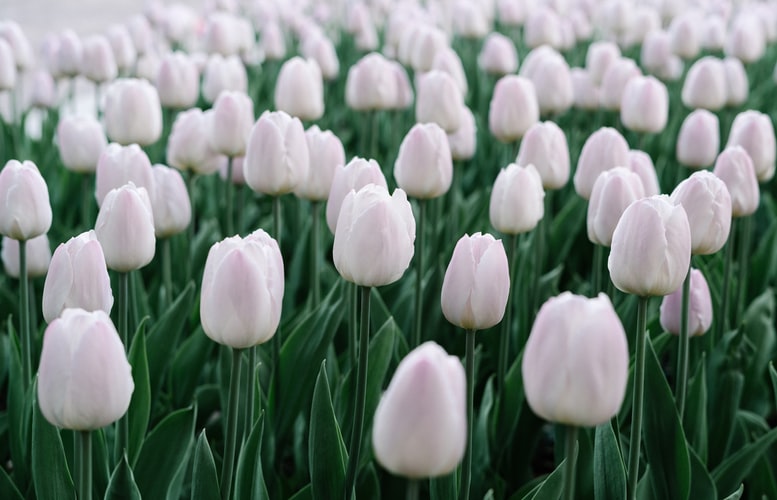
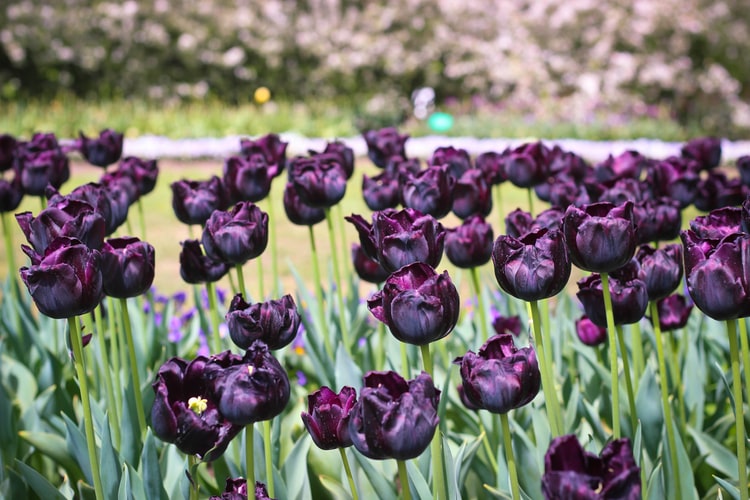
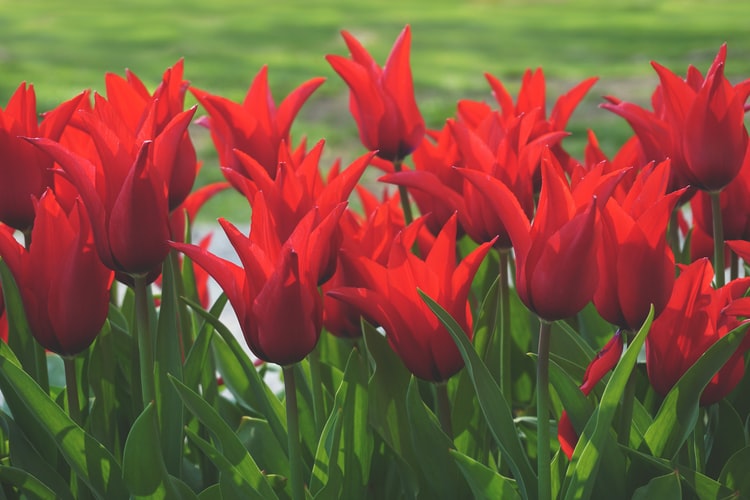
Classification
In general, tulips are classified according to the flowering season, as follows:
- early tulips – are those that bloom in early April. They can be varieties with single or double flowers, large or smaller. Example: Duc Van Tol, T. gerneriana x T. suaveolens.
- semi-early tulips – are those that bloom in the second half of April. Example: Mendel, Triumph.
- late tulips – bloom in May. They can be varieties with single or double flowers. Examples: Breeder, Lilium, Cottage, Bizare, Rembrandt, Parrot etc.
Due to climate change and the changing environmental conditions of recent years, the moment of flowering may differ by a few days or weeks.
Environmental conditions
Light. Tulips require abundant light for correct and harmonious development, therefore it is recommended to place them in a place as bright as possible in the garden. Shade, insufficient light, or cloudy days determine the loss in value of the decorative aspect of the flowers, the thinning of the leaves, and the breaking of the stems.
Temperature. During the year, tulips need different temperatures to carry out specific physiological processes. Thus, after planting the bulbs, they require temperatures of 5-7° C for root formation. High temperatures cause the development of a weakened root system, making the plants more sensitive in winter. The sprouting of the leaves takes place when the air reaches temperatures of 3-4° C and the snow begins to melt. The development of the stem and the growth of the plant takes place at constant temperatures of 12-16° C. Sudden variations in temperature during this period (decrease/increase in temperature) can lead to an out-of-balance growth and poor flower formation or to the shortening of the flowering period.
Humidity. In general, tulips have high requirements for humidity during the development of the aerial parts and flowering. In a temperate continental transitioning into an oceanic climate, the necessary water is provided by rainfall. If, however, drier periods occur, irrigation is required in order to maintain damp soil. Sprinkler irrigation is recommended to create a high atmospheric humidity, which is preferred by tulips.
Soil. Tulips need a fertile, light, and well-drained substrate. They do not tolerate well heavy soils, so it is recommended to supplement with sand and garden soil.
Planting tulip bulbs
The best time to plant the bulbs is from October to early November. For the correct rooting of the bulbs, the soil must be damp, so, during dry autumns, it is recommended to irrigate the land a few days before and after planting. The planting depth is 10-15 cm. In case of late planting or in mountainous areas, with colder winters, it is recommended to cover the land with a 3-5 cm layer of mulch. This layer has to be removed in early spring.
Fertilization
In general, tulips need large amounts of fertilizer for optimal growth. Granular fertilizers, NPK type, enriched with trace elements are preferred. In autumn, after planting the bulbs, first fertilization is recommended. During the period of bud formation and flowering, tulips consume the largest amounts of nutrients, so fertilization is required during this period as well.
Recommended products
-
You can find products on a different store
Change Store -
You can find products on a different store
Change Store -
You can find products on a different store
Change Store -
You can find products on a different store
Change Store -
You can find products on a different store
Change Store -
You can find products on a different store
Change Store -
You can find products on a different store
Change Store -
You can find products on a different store
Change Store -
You can find products on a different store
Change Store -
You can find products on a different store
Change Store -
You can find products on a different store
Change Store -
You can find products on a different store
Change Store -
You can find products on a different store
Change Store -
You can find products on a different store
Change Store -
You can find products on a different store
Change Store -
You can find products on a different store
Change Store -
You can find products on a different store
Change Store -
You can find products on a different store
Change Store -
You can find products on a different store
Change Store -
You can find products on a different store
Change Store -
You can find products on a different store
Change Store -
You can find products on a different store
Change Store -
You can find products on a different store
Change Store -
You can find products on a different store
Change Store
Diseases and pests
Diseases that can occur in tulips are gray mold, fusarium wilt, and the rotting of the area between the roots and the stem. In their case, it is recommended to apply treatments with specific fungicides.
Recommended products
-
You can find products on a different store
Change Store -
You can find products on a different store
Change Store -
You can find products on a different store
Change Store -
You can find products on a different store
Change Store -
You can find products on a different store
Change Store -
You can find products on a different store
Change Store -
You can find products on a different store
Change Store -
You can find products on a different store
Change Store -
You can find products on a different store
Change Store -
You can find products on a different store
Change Store -
You can find products on a different store
Change Store -
You can find products on a different store
Change Store -
You can find products on a different store
Change Store -
You can find products on a different store
Change Store -
You can find products on a different store
Change Store -
You can find products on a different store
Change Store -
You can find products on a different store
Change Store -
You can find products on a different store
Change Store -
You can find products on a different store
Change Store -
You can find products on a different store
Change Store -
You can find products on a different store
Change Store -
You can find products on a different store
Change Store -
You can find products on a different store
Change Store -
You can find products on a different store
Change Store
The pests that can infest tulips are aphids, mites, and nematodes. The control is done with specific insecticides/acaricides.
Recommended products
-
You can find products on a different store
Change Store -
You can find products on a different store
Change Store -
You can find products on a different store
Change Store -
You can find products on a different store
Change Store -
You can find products on a different store
Change Store -
You can find products on a different store
Change Store -
You can find products on a different store
Change Store -
You can find products on a different store
Change Store -
You can find products on a different store
Change Store -
You can find products on a different store
Change Store -
You can find products on a different store
Change Store -
You can find products on a different store
Change Store -
You can find products on a different store
Change Store -
You can find products on a different store
Change Store -
You can find products on a different store
Change Store -
You can find products on a different store
Change Store -
You can find products on a different store
Change Store -
You can find products on a different store
Change Store -
You can find products on a different store
Change Store -
You can find products on a different store
Change Store -
You can find products on a different store
Change Store -
You can find products on a different store
Change Store -
You can find products on a different store
Change Store -
You can find products on a different store
Change Store
In addition:
- the early falling of the flowers / flowering failure is often caused by high temperatures after planting the bulbs.
- the bulbs removed from the ground and stored have to be kept at a temperature of 5° C.















































































































































































































































































































































































































































